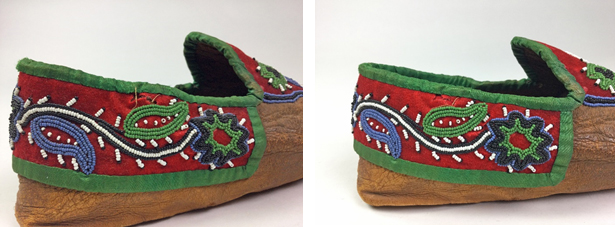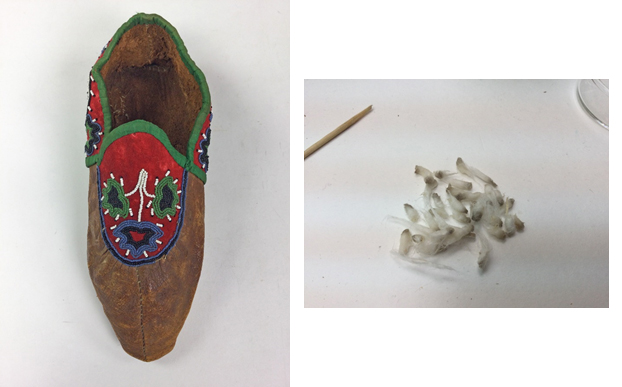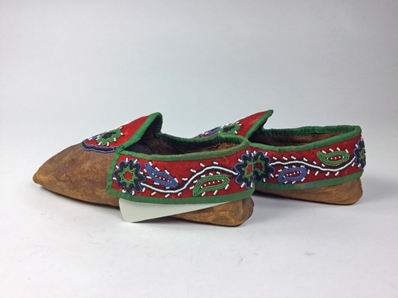The BSM has had an ongoing loan project with the National Gallery of Canada, Ottawa, for more than 15 years. It’s a great opportunity to showcase the collection in a world renowned institution that receives thousands of international visitors every year, COVID-19 lockdowns aside!
The next loan includes 9 pairs of moccasins, 1 pair of mukluks and 1 pair of kamiks that will leave for Ottawa sometime in June of this year. The process of preparing a loan involves examining each artefact and determining if conservation treatment is necessary, then writing detailed condition reports which are accompanied by photographs.
These Tlingit moccasins were made of alder bark tanned hide with beautifully beaded red wool collars and aprons. The red alder tree grows along the southeast coast of Alaska, along the west coast of British Columbia and down to California. The outer bark was peeled off the tree and steeped in water to which the hide was added until the desired effect was achieved. This acts as a tanning process, while at the same time dyeing the hide a warm, rich reddish brown colour.
The moccasins were in relatively good condition: there was surface dust caught between the beads and trapped in the nap of the wool and in the recesses of the pleats around the apron. The beadwork was quite dirty, there were moth holes in the wool and the shape of the collar was distorted around the topline. The first step was to photograph the damage so that there is a record of what the moccasins looked like before treatment began. The thread ends around missing beads were secured to prevent further loss before cleaning started.
The picture on the left shows the holes in the red wool with thread ends that would have had strands of white/black beads that extend from the bottom of the green leaf design. On the right the holes have red wool fills; the thread ends are secured to the wool, the beads are clean.
Loose surface dirt was removed with a low suction vacuum with a micro nozzle and soft bristle brushes. Dirt was removed from the surface and between the beads using a solution applied with cotton swabs and micro brushes.
This was the grime removed from the beadwork on this moccasin apron.
The action was gentle so as not to dislodge beads from the fragile old threads on which they were strung. Red wool of a similar weight and colour was slipped behind some of the larger holes to provide support to the surrounding fabric and make them less visually distracting. The ‘brightness’ of the new wool was toned down with powdered pencil clay. The stiff topline was too fragile to humidify and manipulate into shape so a stiffener was created out of unbuffered acid free cardstock, softened with a burnishing tool, and slipped under the collar.
The green-grey card band hides between the collar & the hide to give the topline its intended shape.
The moccasins were slightly tippy which means they would rock back and forth in the display case. Weights were added to the interior in the forepart under the apron for stability. The vamps needed support to help keep their shape. Padding was added and covered with a dark brown fabric that will hide in the shadow of the front of each moccasin. All moccasins for this loan have the same interior treatment to create visual uniformity.
Hopefully museums and art galleries will be able to open to visitors this summer. If you have the opportunity, check out the Canadian and Indigenous Art galleries on Level 1 at the National Gallery of Canada to see the incredible creativity spanning 5000 years.
Ada Hopkins, Conservator





